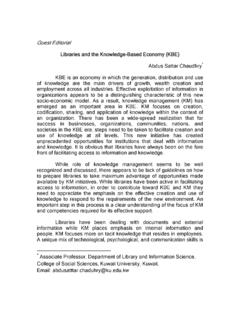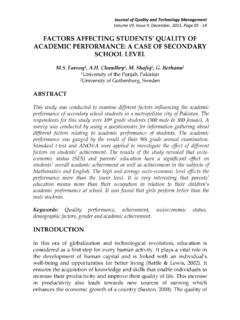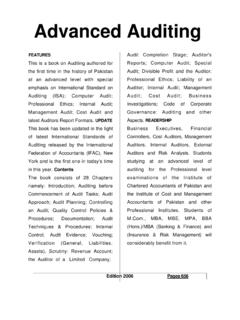Transcription of SYNTHESIS OF TALLOW BASED ESTERQUAT
1 ISSN 0555-7674 SYNTHESIS OF TALLOW BASED ESTERQUAT 1111 Mehwish Akram, Waheed-uz Zaman, Zaib Hussain Muhammad Salman,213 Umer Shafique, Rabia Rehman and Jesus Anzano1 Institute of Chemistry, University of the Punjab, Lahore, PK2 Center for Undergraduate Studies, University of the Punjab, Lahore, PK3 Laser Laboratory & Environment, Analytical Chemistry Department, Faculty of Sciences, University of Zaragoza, Pedro Cerbuna 12, 50009 Zaragoza, SpainAbstract: ESTERQUAT which is basically the class of surface active quaternary +-ammonium compounds have general formula RNX .Locally available cheap raw 4material were used to synthesized cationic fabric softeners.
2 Free fatty acids were derived ofrom beef TALLOW and were treated with triethanolamine at 135C. The obtained di-ester was refluxed with different mole ratios of dimethyl sulphate to obtain a viscous quaternary ammonium compound; the best mole ratio for DMS to ESTERQUAT was :1. The synthesized Esterquats were evaluated for percentage yield ( ) and cationic content ( ). Physical and chemical properties were evaluated by various tests like feel panel test, water absorbing capacity and heat stability on different fabric substrates , synthetic as well as natural. It was further characterized by IR treatment time and generally, Mostly Quats are solids and have exhaustion should take place in about indefinite melting point and decompose five minutes, for the softener to be on heating.
3 Lower molecular Quats are effective and economically useable. It soluble in water tetra methyl must impart softness, fluffiness and ammonium chloride(1) while solubility lubricity to the treated cloths and reduce decreases in polar solvent and increases static build up (5). The first fabric in non polar solvent with the increase in softeners were developed for the textile molecular weight of quaternary industry during the early twentieth ammonium compound (> C10) (1-3). century. At that time the process used to dye cotton fibers left them feeling harsh Higher order quaternary ammonium to skin.
4 In the early 1900s, preparations compound exhibit surface active known as cotton softeners were properties and are known as cationic developed to improve the feel of cotton surfactant. (4). It is the main constituent fibers after dyeing. A typical cotton of fabric softener composition. Fabric softener consisted of seven parts water, softener also called Fabric Conditioner is three parts soap, and one part olive, corn, used to prevent static cling and make or TALLOW . Cationic softeners were fabric feel softer. Popular brand names discovered in the early 20th century but include Lenor, Downy, Snuggle, and were not used by textile industry until the Comfort.
5 The use of fabric softener may late 1930's (6). They become technically however reduce the water absorption important after Domagk discovered their capabilities of the fabric, and is bacteriostatic and fungicidal properties contradicted in some articles like (7). microfiber textiles. An effective softener must be readily dispersible in rinse water The first house hold fabric use softener and rapidly absorbed so that uniform was produced in in 1955's was di deposition on the fabric can occur within (hydrogenated TALLOW ) dimethyl 1-For Proof and Correspondence: Mehwish AkramJournal of Scientific ResearchVol.
6 XXXX No. 1, June, 201032ammonium chloride (8). Softeners were an effective fabric conditioner. (14) introduced about 10 years later in Europe (9-10) Triethanolamine (TEA)- BASED Esterquats are generally prepared by ESTERQUAT has been the primary ingredient reaction of two mole of TALLOW fatty acid in European fabric softeners for several and one mole of triethanolamine then the years and is becoming the global diester was quarernized by (dimethyl molecule of choice. Although it has an sulfate) environmental profile, TEA ESTERQUAT has been plagued by mediocre Material and methodsperformance compared to historical All the chemical used for the SYNTHESIS of molecules such as dihydrogenated TALLOW Diester and ESTERQUAT were of chemical dimethyl ammonium chloride and imidazoline quat.
7 (11)ApparatusBeside anionic, silicon and non ionic Rotary evaporator with Chiller, Burette, fabric softener mostly cationic fabric pipette, round bottom flask, stirring hot softener are commonly used. The fabric plate with Teflon are called cationic because the positive charged hydrophilic parts are Experimental workpredominant in the rinse water when 1. Isolation of free fatty acid from cationic softeners are added. Major area tallowof cotton fabric is negatively charged, so For the preparation of free fatty acids all the cations are picked up by the fabric various steps were performed. In the first and are retained on the fabric during the step saponification of TALLOW was rinsing process when fabric softeners are calculated.
8 For this g of soap was applied. The hydrophobic part of fatty taken in 250ml volumetric flask and was hydrocarbons is the agent that causes dissolved in small amount of cationic softeners to soften the fibers in isopropanol. 2 drops of phenolphthalein fabric (12)was added as indicator. It was titrated with alcoholic KOH with constant Beside the fabric softening the ESTERQUAT shaking until pink color produced which commonly form the foundation of persisted for 15 in the antimicrobial industry. Many studies have been 100g of TALLOW was weighed and was conducted on the biological activity of heated in beaker on hot plate until it was surfactants derived from fatty acids viz.
9 Melted. Then 50% sodium hydroxide lauric acid, myristic acid, stearic acid and solution was added in it maintaining the palmitic acid and palm fatty acid with temperature at 105 C, alkali was added polyamine, 1(2-hydroxyethylpi-in little excess until there was no increase perazine). (13)in free fatty acid inclusion of ester linkages into the aliphatic chains has significantly improved the kinetics of biodegradation of the cationic surfactants, lowering the environmental exposure levels. This new generation of fabric softening agents combines a good environmental profile with the structural features required for -OCR1O-OCR2O-OCR3 ONa+Na+Na+ HCHOC R1 OCHOC R2 O CHOC R3 O HHC H OC H OC H OH+NaOH Mehwish Akram33 The acid hydrolysis of prepared soap was 250 ml round bottom flask.
10 Thermometer performed and for this glycerin was was inserted in one neck of flask and removed. Soap was stirred with condenser was fitted on other neck. sufficient amount of water until to get When the diester was completely honey consistency. Mechanical stirrer dissolved in it, then of dimethyl was used in this operation. In this way a sulphate ( g) was added drop by drop uniform sticky solution was formed. It with constant stirring at 70 C. Reaction was treated with 7N HCl solution to get mixture was stirred for 2 hour. ESTERQUAT highly acidic pH. The upper free fatty contents were transferred to a beaker and acids were decented.






![nÁ0` h]´ VP h^ÄE°h´ÅÊQ⌦µh^˨½ DÅ⌦En¨½ À¹ ÌÄjÅ⌦ÊPÅj {´Ì](/cache/preview/7/8/7/0/6/2/b/7/thumb-787062b7e87e0e8e4ae0396a2098f16c.jpg)


